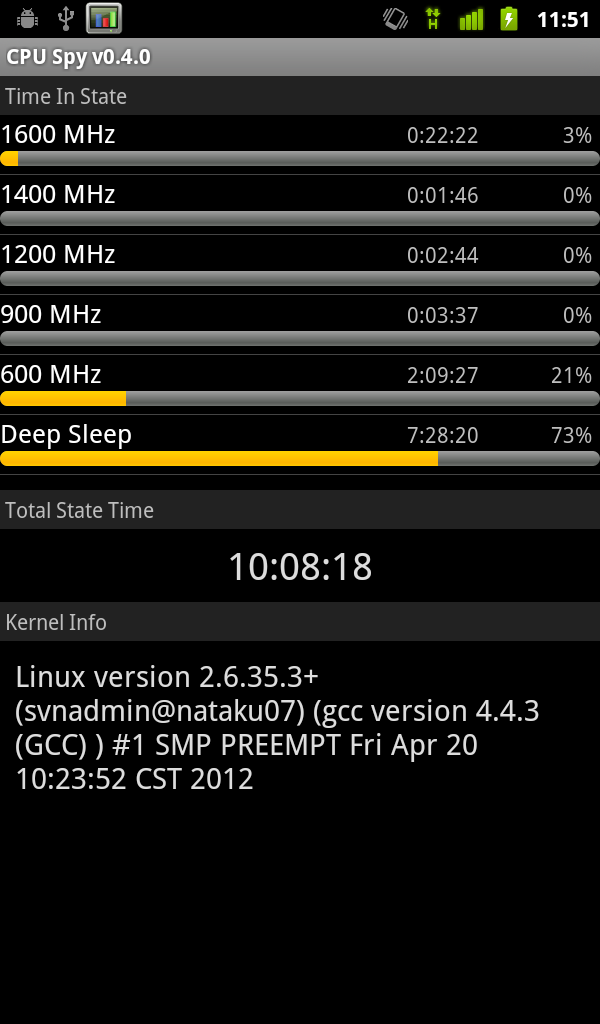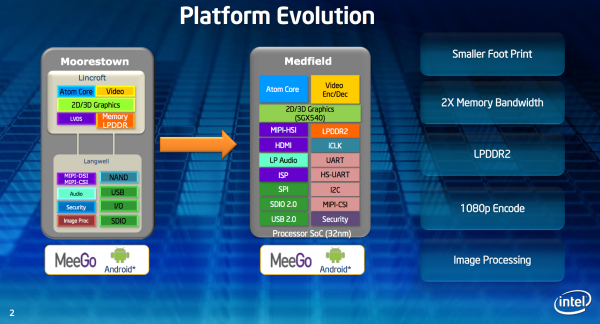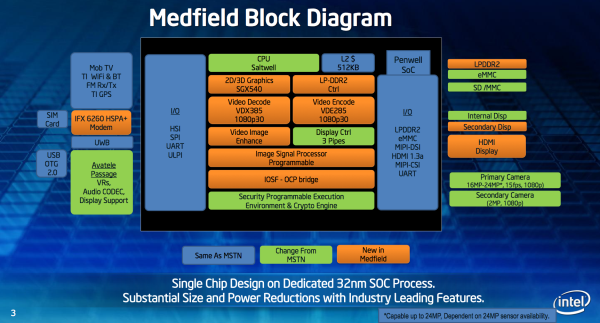Lava Xolo X900 Review - The First Intel Medfield Phone
by Brian Klug on April 25, 2012 6:00 AM ESTMedfield: Intel in a Smartphone
I touched on this before but there were a number of reasons we never saw Moorestown in a smartphone. One part of the problem was the number of packages required to implement the platform, the other was that it simply lacked some of the things that smartphone OEMs implicitly expect to live on an SoC. The internal Intel guidance was that Moorestown required 2 packages to implement (Lincroft and Langwell), and in addition to those two you needed an external PMIC and DRAM. There wasn’t support for PoP memory, only external LPDDR1, and there was only support for 5 MP camera and 720p encode.
Medfield builds in every way on top of this by delivering a bona fide SoC with PoP LPDDR2 (2 x 32 bit support), improved ISP from Intel’s Silicon Hive acquisition, video encode and decode blocks from Imagination, SGX 540 graphics at 400 MHz, additional I/O, and an external Avatele Passage PMIC (Intel calls this an MSIC). The result is a platform that looks to an OEM like any of the other competitors - it’s a combination of SoC, PMIC, and some PoP LPDDR2, as opposed to the previous solution which required two additional external packages. Intel has a few slides online about this evolution and how things have moved inside the single Medfield package, and the result again is something that finally looks like any one of countless ARM-based SoCs.
The specific part inside the X900 is an Atom Z2460 32nm SoC (the platform is Medfield, Penwell is the SoC, and the CPU inside is a Saltwell), and inside a Penwell is the Atom Saltwell core running at up to 1.6 GHz with 512KB of L2 cache, a PowerVR SGX 540 GPU at 400 MHz, and a dual channel LPDDR2 memory interface. Anand has already written about the CPU architecture itself pretty comprehensively, and how it compares to ARM’s Cortex A9 and A15 designs. The long and short of it is that Saltwell is still a dual-issue, in-order core with Hyper-Threading support. There’s a 16 stage integer pipeline, no dedicated integer multiply or divide units (they’re shared with the floating point hardware), and in addition to the 512KB L2 cache there’s a separate 256KB SRAM which is lower power and on its own voltage plane. When Saltwell goes into its deepest sleep state, the CPU state and some L2 cache data gets parked here, allowing the CPU voltage to be lowered even more than the SRAM voltage. As expected, with Hyper-Threading the OS sees two logical cores to execute tasks on.
The other interesting thing is support for EIST and additional C states when the device is idle. Dynamic CPU clocks through the linux governor is something absolutely critical for getting a smartphone with acceptable battery life. What’s interesting here is that Penwell’s advertised dynamic range is between 100 MHz and 1.6 GHz with fine grained 100 MHz increments between, in addition to the C6 state where CPU state data is saved in the on-SoC low power SRAM and the platform is basically suspended (deep sleep).
However, the Android governor onboard the X900 only includes a few steps between 600 MHz and the maximum 1.6 GHz burst clock, in addition to C6. You can see this either by inspecting the governor’s available scaling frequencies:
$ cat /sys/devices/system/cpu/cpu0/cpufreq/scaling_available_frequencies 1600000 1400000 1200000 900000 600000 $ cat time_in_state 1600000 233495 1400000 12304 1200000 19780 900000 25801 600000 5306262
Or by using an Android application which inspects exactly this data. I spent a day with the Medfield phone in my pocket and made a note of capturing what the state data was after the day’s end, and the CPU does indeed go into C6 while idle and in the pocket, and spend a lot of time at the minimum 600 MHz clock with some bursts to 1.6 GHz when I’m doing things.


The reality is that most of the smartphone’s time is really spent idling, waking up only to watch some DRX slots or process background tasks. It is curious to me however that Intel isn’t implementing their Ultra-LFM modes between 100 and 600 MHz - it’s possible there’s no voltage scaling below 600 MHz which in turn doesn’t make it worth jumping into these lower clocks quite yet.
Depending on the device’s thermals, Intel’s governor will select between those available frequencies. There actually are four thermal zones in the device, on the back, front, baseband, and SoC itself. The SoC can go up to 90C before you get throttled (which is pretty typical for Intel CPUs), 75 C on the back, 64 C on the front, and 80 C on the modem. Those sound high but aren’t out of the ordinary for some of the other SoCs I’ve seen who have similar thermal management. In addition, if the platform gets too hot, the display brightness will be clamped to 50%.
I have to admit that I did see the display brightness get clamped once as shown above, but only once during a period where I was running the display at 100% brightness and maxing out the CPU. The bottom back of the X900 can indeed get warm, but nothing inordinate or near the thermals that are set in the software management.
Finally, Saltwell supports the same instruction set as Core 2, including SSE3 and Intel 64. We can check this by looking at the CPU flags from cpu_info as well:
processor : 0vendor_id : GenuineIntelcpu family : 6model : 39model name : Intel(R) Atom(TM) CPU Z2460 @ 1.60GHzstepping : 2cpu MHz : 600.000cache size : 512 KBphysical id : 0siblings : 2core id : 0cpu cores : 1apicid : 0initial apicid : 0fdiv_bug : nohlt_bug : nof00f_bug : nocoma_bug : nofpu : yesfpu_exception : yescpuid level : 10wp : yesflags : fpu vme de pse tsc msr pae mce cx8 apic sep mtrr pge mca cmov pat clflush dts acpi mmx fxsr sse sse2 ss ht tm pbe nx constant_tsc arch_perfmon pebs bts nonstop_tsc aperfmperf pni dtes64 monitor ds_cpl vmx est tm2 ssse3 xtpr pdcm movbe lahf_lm arat tpr_shadow vnmi flexprioritybogomips : 3194.88clflush size : 64cache_alignment : 64address sizes : 32 bits physical, 32 bits virtualpower management:
The rest of the Medfield platform we’ll talk about in the appropriate sections, but the big takeaway is that Intel finally has a real x86 SoC for smartphones and tablets. In addition to the Z2460 that we’re looking at in the X900, Intel has two other SKUs which round out the high end and low end. At the low end is the Z2000 which is functionally identical to the Z2460 but with a maximum CPU clock of 1.0 GHz, no HT, and an SGX 540 clock of 320 MHz, and the Z2580 which is clearly targeted at Windows 8 tablets with two Saltwell cores clocked up to 1.8 GHz, and PowerVR SGX544MP2 graphics at 533 MHz for Direct3D 9_3 compliance.












106 Comments
View All Comments
jwcalla - Wednesday, April 25, 2012 - link
Well... it's competitive. Ultimately it'll come down to who has the most desirable device. We know Apple has it's iPhone... Samsung the Galaxy S... Motorola the Droid Razr, etc. Intel would need to get in with one of those companies and be a top device to be accepted. Nobody is going to buy it just because it's Intel. (Except the fanboys of course.)dt1561 - Wednesday, April 25, 2012 - link
Looks cool but nothing extraordinary.fic2 - Wednesday, April 25, 2012 - link
Not that it matters much but does the display use Gorilla Glass?snoozemode - Wednesday, April 25, 2012 - link
Sure it's fun that Intel finally has proven that x86/Atom works in a smartphone, but the overall result is just a very bland phone that's not superior at anything really. And with a price of $420.. Why would anyone buy this?A5 - Wednesday, April 25, 2012 - link
That's $420 with no contract. Considering the average carrier subsidy is $300-$400, this is a firmly mid-range device.fm123 - Thursday, April 26, 2012 - link
That is the price in India, which could be a completely different situation than other countries.sonicmerlin - Wednesday, April 25, 2012 - link
So given the nature of x86, can we self-install other compatible operating systems such as an x86 port of MeeGo? I'm *very* interested in using MeeGo outside of the N9. What about the x86 ICS image that Google makes available on its own website? Are there any customization or tweaking requirements, or can we install any new OS the same way we would install Linux or Windows on typical x86 hardware?That would be the ultimate advantage of an x86 phone or tablet, no?
Finally, the battery tests here don't discuss standby battery life. That's always been an issue with Android, and is why every other OS seems to have much longer battery life than Android. We don't use our smartphones the way these battery torture tests suggest we do. Could you please download an app like Battery Monitor Widget and indicate how many mA are being used during standby?
dcollins - Wednesday, April 25, 2012 - link
Installing a new OS requires supported drivers. MeeGo could be installed in theory if you ported the necessary drivers from Android. They are both Linux based, so this is theoretically possible, but it will require a lot of hacking and technical expertise. The Windows driver model is totally different so you would have to reverse engineer drivers from scratch. That's not going to happen.This fight is not about x86 versus ARM as ISAs. It's about Intel versus ARM licensees: who can develop a faster, lower power chip? If Intel does their job well, the ISA shouldn't matter to the end user.
sonicmerlin - Thursday, April 26, 2012 - link
I think you misunderstand. MeeGo already provides support for x86. Technically it's now "Tizen", but regardless it's been developed with both ARM and x86 in mind. My main question is whether we can self-install an x86 port of MeeGo (or Tizen) onto this phone?fteoath64 - Saturday, April 28, 2012 - link
¨This fight is not about x86 versus ARM as ISAs. It's about Intel versus ARM licensees¨It blows down to just that!. The cost efficiency of ARM chips will just kill any chance of Intel getting into this market. Just look at a completely built Android handset made in china with retina display for $119. A retailer selling it for $160-199 will made heaps, if billions of units are involved. All licenses of chips and Android are legit. Not copycat stuff. Genuine Cortex A9 licenses.
It comes at a time when having 4-5 suppliers of ARM chips have made the market very resilient, something a single supplier can never do. So I say to Intel again, get an ARM license and play this game the right way. You can innovate very nicely with competition, and you really need that competition to keep your edge.